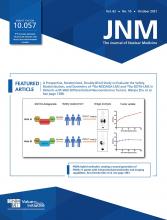Management of patients with neuroendocrine neoplasms (NENs) is a complex task and warrants referral of these patients to high volume centers with appropriate expertise in order to ensure favorable outcomes and appropriate follow-up. PET/CT becomes increasingly important in almost every step of patient management and outcomes. In the recent years, somatostatin receptor (SSTR) PET/CT using 68Ga-labeled somatostatin analogs ([68Ga]Ga-SSAs) has proven to be successful in the evaluation of well-differentiated gastroenteropancreatic NENs, and it is also tightly connected to the use of targeted radiotherapy (peptide receptor radionuclide therapy [PRRT]) in inoperable and progressive metastatic cases. Therefore, it has been deemed as a first “grab” tracer in many consensus and position statements made by expert panels (1,2). There has been global enthusiasm and excitement surrounding [68Ga]Ga-SSA, including its added value compared with previously used 99mTc- or 111In-based somatostatin receptor scintigraphy, its worldwide availability, and on-site production. This, however, has thrown the baby out with the bathwater in regard to 18F-FDOPA PET. SSTR PET is clearly superior to 18F-FDOPA PET for certain NENs and should be positioned at the forefront of pancreatic NENs (except for insulinomas, for which data are still scarce and GLP1-receptor imaging appears to be more promising). However, is this also the case for small intestine NENs (SI-NENs)?
The selection of a specific radiopharmaceutical is important in distinguishing between diagnostic and theranostic settings. In a theranostic setting (a time and cost-effective approach), SSTR PET is used as an evidence-based companion diagnostic for selecting candidates who will likely benefit from PRRT, regardless of tumor origin. 18F-FDG also has great potential for predicting outcomes to PRRT. What is the role 18F-FDOPA in the evaluation of NENs if it cannot be used in a theranostic setting and has the potential to be more costly? Are the data, usage, and popularity of [68Ga]Ga-SSAs enough to disqualify or abandon 18F-FDOPA in countries where it is approved, available, and previously used? Can we truly abandon 18F-FDOPA when we have seen it be more specific, have higher resolution, and have less small intestine activity compared with [68Ga]Ga-SSA? Are both tracers similar in terms of sensitivity? Until recently, no study has specifically addressed this issue. Three historical studies have compared 18F-FDOPA PET/CT and SSTR PET/CT in a small case series (3–5). Although interesting, each study is hampered by mixing NENs of various origins with a very small number of pathologically proven SI-NETs, which may have decreased the performance of 18F-FDOPA.
More recently, 3 studies have compared 18F-FDOPA PET/CT and SSTR PET/CT in gastroenteropancreatic NENs, focusing on SI-NENs (6–8). Although retrospective, these studies provide novel insights and analysis on optimal evaluation of patients with rare diseases. Our group retrospectively evaluated [68Ga]Ga-DOTATOC and carbidopa-assisted 18F-FDOPA PET/CT in 41 patients with well differentiated ileal NETs (7). All patients’ primary tumors were previously resected and all were investigated by PET for restaging. 18F-FDOPA PET/CT had a better detection rate than [68Ga]Ga-DOTATOC (96% vs. 80%, P < 0.001). In a total of 605 lesions, 458 (76%) were positive on both modalities, 25 (4%) by [68Ga]Ga-DOTATOC only, and 122 (20%) by 18F-FDOPA PET/CT only, corresponding to liver, peritoneal, or lymph node metastases. Because of the recruitment of patients with extensive metastases, both examinations yielded a similar management plan. Ansquer et al. have compared 18F-FDOPA PET/CT (without carbidopa premedication) and [68Ga]Ga-DOTANOC in a series of 30 patients with SI-NENs (6). PET/CT studies were performed for initial staging in 9 cases and restaging in the remaining cases. 18F-FDOPA PET/CT detected significantly more lesions than [68Ga]Ga-DOTANOC, with sensitivities of 95.5% and 88.2%, respectively. 18F-FDOPA PET/CT detected more lesions in 9 cases with 22 additional lesions from variable locations. [68Ga]Ga-DOTANOC was superior to 18F-FDOPA PET/CT in only 3 cases with a limited number of additional lesions. In concordant liver metastases, the tumor-to-liver uptake ratio was superior in 18F-FDOPA compared with [68Ga]Ga-DOTANOC in 63% of cases. A more favorable uptake ratio in 18F-FDOPA could potentially explain the higher detection rate of liver metastases. It is expected that SSTR antagonists could perform better than agonists in this setting. Lastly, Veenstra et al. have compared 18F-FDOPA (under carbidopa) and [68Ga]Ga-DOTATOC PET/CT in 45 NEN patients, including 23 (51%) SI-NENs, followed by pancreatic, large intestine, lung, ovarium, and NENs of unknown origin. Considering the subgroup of SI-NENs, 18F-FDOPA detected more lesions than [68Ga]Ga-DOTATOC in 16 of 23 patients (70%) whereas [68Ga]Ga-DOTATOC detected more lesions than 18F-FDOPA in only 4 of 23 patients.
Taken collectively, these results show that both SSTR PET/CT and 18F-FDOPA PET/CT are excellent for disease staging and restaging, although 18F-FDOPA PET/CT is frequently the most sensitive tracer (Fig. 1). Therefore, there is no reason to disqualify its use in the face of simplifying paradigms. This conclusion aligns with the 2017 European Association of Nuclear Medicine guidelines for PET/CT imaging of NENs (9). Additionally, 18F-FDOPA PET/CT provides a specific molecular signature linked to serotonin secretion and potential underlying biologic characteristics. This has been illustrated in pheochromocytoma and paraganglioma, where imaging phenotype is tightly linked to tumor location (sympathetic versus parasympathetic paraganglia; adrenal versus extra-adrenal), genetic status, biochemical phenotype, and size, with all being intimately interconnected (10). In conclusion, 18F-FDOPA PET/CT can perform better than SSTR PET in SI-NETs. These findings could be important in a diagnostic setting before major operations such as hepatic cytoreductive surgery or liver transplantation.
Illustrative image showing superiority of 18F-FDOPA (A) over [68Ga]Ga-DOTATOC (B) in patient with SI-NET. SUV-bw = body weight–normalized SUV; T = top; B = bottom.
DISCLOSURE
No potential conflict of interest relevant to this article was reported.
Footnotes
Published online March 26, 2021.
- © 2021 by the Society of Nuclear Medicine and Molecular Imaging.
REFERENCES
- Accepted for publication February 14, 2021.
- Accepted for publication March 19, 2021.








